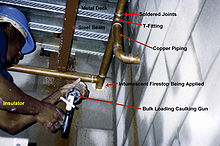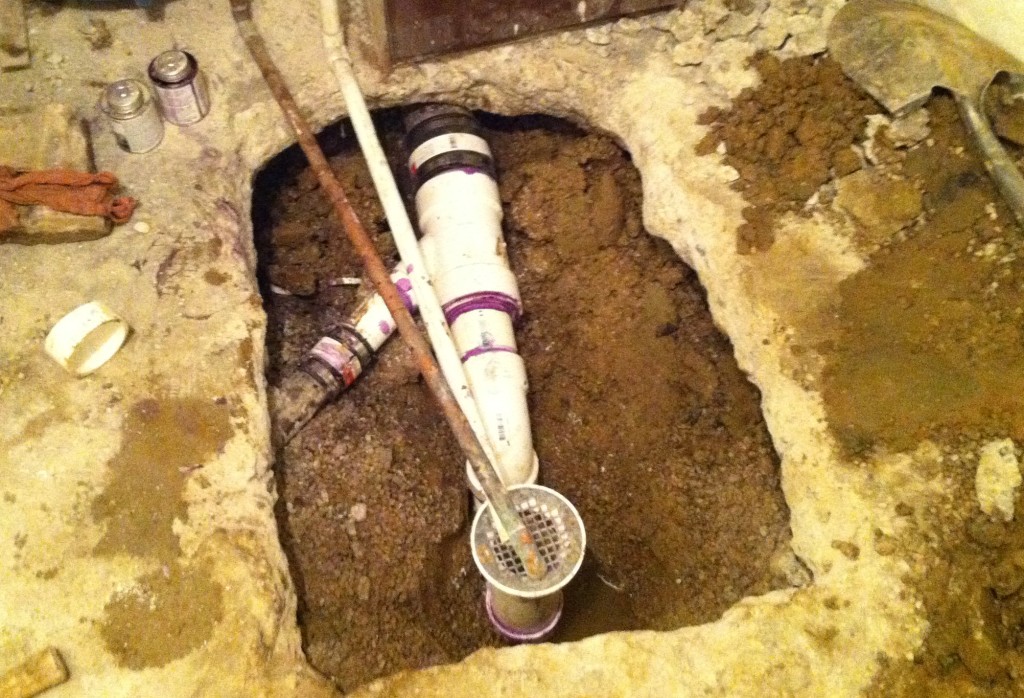Cincinnati Plumbing !
The PlumbTree Company has a big focus on Drain Cleaning amongst other varieties of Cincinnati Plumbing Services.
Our $89 Drain Cleaning offer is unmatched by our Cincinnati Plumbing Competitors in the Cincinnati Area as we stand by our price and our word to make sure every customer we serve is satisfied !
Cincinnati Plumbing
The system of pipes, plumbing drain fittings, valves, valve assemblies, and devices installed in a building for the distribution of water for drinking, heating and washing, and the removal of waterborne waste, and the skilled trade of working with cincinnati plumbing pipes, Cincinnati plumbing tubing and cincinnati plumbing fixtures in such systems. A Cincinnati plumber is someone who installs or repairs piping systems, plumbing fixtures and equipment such as water heaters and backflow preventers. The Cincinnati plumbing industry is a basic and substantial part of every developed economy due to the need for clean water, and sanitary collection and transport of waste. The word “plumbing” comes from the Latin plumbum for lead, as all plumbing pipes were once made from lead.
Plumbing is usually distinguished from water supply and sewage systems, in that a Cincinnati plumbing system serves one building, while water and sewage systems serve a group of buildings.
Contents
Cincinnati Plumbing History

Plumbing originated during ancient civilizations such as the Greek, Roman, Persian, Indian, and Chinese cities as they developed public baths and needed to provide potable water and drainage of wastes, for larger numbers of people. Standardized earthen plumbing pipes with broad flanges making use of asphalt for preventing leakages appeared in the urban settlements of the Indus Valley Civilization by 2700 B.C. The Romans used lead pipe inscriptions to prevent water theft. Go Cincinnati Plumbing !
Improvement in plumbing systems were very slow with virtually no progress at all made from the time of the Roman aqueducts and lead pipes. Believe it or not plumbing was extremely rare until the growth of modern densely-populated cities in the early1800s. During this period public health authorities began pressing for better waste disposal systems to be installed, to prevent or control epidemics of disease. Earlier, the waste disposal system had merely consisted of collecting waste and dumping it on the ground or into a river.. Eventually the development of separate, underground water and sewage systems eliminated open sewage ditches and cesspools. Thus Plumbing was born!
Most large cities today use plumbing pipes to deliver solid waste to sewage treatment plants in order to separate and partially purify the water, before emptying into streams or other bodies of water. For potable water use, plumbing introduced galvanized iron piping was commonplace in the United States from the late 1800s until around 1960. After that period, copper piping took over, first soft copper with flared fittings, then with rigid copper tubing utilizing soldered fittings… Go Cincinnati Plumbing !
The use of lead for potable water declined sharply after the Second World War because of increased awareness of the dangers of lead poisoning. At this time, copper piping was introduced as a better, and safer alternative to lead pipes. Cincinnati Plumbing has come a long way…
Cincinnati Plumbing Materials
Present-day water-supply systems use a network of high-pressure pumps, and pipes in buildings are now made of copper,brass, plastic (particularly cross-linked polyethylene called PEX which is estimated to be used in 60% of single-family homes), or other nontoxic plumbing material. Due to its toxicity, lead has not been used in modern water-supply piping since the 1930s in the United States, although lead was used in plumbing solder for drinking water until it was banned in 1986. Plumb Drain and vent lines are made of plastic, steel, cast-iron, or lead. Plumb Water systems of ancient plumbing times relied on gravity for the supply of water, using plumbing pipes or plumbing channels, usually made of clay, lead, bamboo, wood, or stone. Plumbing also used Hollowed wooden logs wrapped in steel banding were used for plumbing pipes particularly water mains. Logs were used for water distribution in England close to 500 years ago. US cities began using hollowed logs in the late 1700s through the 1800s.
The straight sections of plumbing systems are called “pipes” or “tubes”. A Plumbing pipe is typically formed via casting or welding, whereas a tube is made through extrusion. Plumbing Pipe normally has thicker walls and may be threaded or welded, while plumbing tubing is thinner-walled and requires special joining techniques such as brazing, compression fitting, crimping, or for plastics, solvent welding. These joining techniques are discussed in more detail in the piping and plumbing fittings article.
Cincinnati Plumbing Components
In addition to lengths of plumbing pipe or tubing, plumbing pipe fittings are used in plumbing systems, such as valves, elbows, tees, and unions. Plumbing Pipe and fittings are held in place with pipe hangers and strapping.
Plumbing fixtures are exchangeable devices using water that can be connected to a building’s plumbing system. They are considered to be “Plumbing fixtures”, in that they are semi-permanent parts of buildings, not usually owned or maintained separately. Plumbing fixtures are seen by and designed for the end-users. Some examples of plumbing fixtures include water closets (also known as toilets), urinals, bidets, showers, bathtubs, utility and kitchen sinks, drinking fountains, ice makers, humidifiers, air washers, fountains, and eye wash stations.
Cincinnati Plumbing Sealants
Plumbing Threaded pipe joints are sealed with thread seal tape or pipe dope. Many plumbing fixtures are sealed to their mounting surfaces with plumber’s putty.
Cincinnati Plumbing Equipment and Tools
Cincinnati Plumbing equipment includes devices often hidden behind walls or in utility spaces which are not seen by the general public. It includes plumbing water meters, pumps, expansion tanks, backflow arrestors, water filters, UV sterilization lights, water softeners, water heaters, heat exchangers, gauges, and control systems.
Specialized Cincinnati plumbing tools include pipe wrenches, flaring pliers, and joining tools such as soldering torches and crimp tools. New plumbing tools have been developed to help plumbers fix problems more efficiently. For example, plumbers use video cameras for inspections of hidden leaks or problems, they use hydro jets, and high pressure hydraulic pumps connected to steel cables for trench-less sewer line replacement.
Cincinnati Plumbing Systems

Copper piping system in a building withintumescent firestop being installed by an insulator, Vancouver, Canada
The major categories of plumbing systems or subsystems are:
- Cincinnati Plumbing Potable cold and hot tap water supply
- Cincinnati Plumbing drainage venting
- Septic systems
- Cincinnati Plumbing Rainwater, surface, and subsurface water drainage
- Cincinnati Plumbing Fuel gas piping
For their environmental benefit and sizable energy savings, hot water heat recycling plumbing units are being installed in residential buildings. Ecological plumbing concerns and water shortages have increased interest in graywater recovery and plumbing treatment systems.
Plumbing may also include hydronics, which involves heating and cooling systems utilizing water to transport thermal energy. The New York City steam system is an example of a large district heating system.
Cincinnati Plumbing Firestopping
Sometimes, a tube or another mechanical part has to penetrate a wall or floor that has special fire insulation material or that have special fire insulation resistance, it is needed to recover the original level of security of the fire system in case of maintenance, or to reach the designed level of security, so to avoid or delay the propagation of flame, smoke and heat accordingly.
Firestopping is a technique used in these cases, and it is required where mechanical penetrants traverse fire-resistance rated wall and floor assemblies, or membranes thereof. This work is usually done worldwide by the insulation trade and/or specialty firestop sub-contractors.
Cincinnati Plumbing Regulation

A Cincinnati plumbing pipe wrenchfor holding and turning Cincinnati plumbing pipes.
Much of the plumbing work in populated areas is regulated by government or quasi-government agencies due to the direct impact on the public’s health, safety, and welfare. Plumbing installation and repair work on residences and other buildings generally must be done according to plumbing and building codes to protect the inhabitants of the buildings and to ensure safe, quality construction to future buyers. If permits are required for work, plumbing contractors typically secure them from the authorities on behalf of home or building owners.
In the United Kingdom the professional body is the Chartered Institute of Plumbing and Heating Engineering (educational charity status) and it is true that the trade still remains virtually ungoverned;there are no systems in place to monitor or control the activities of unqualified plumbers or those home owners who choose to undertake installation and maintenance works themselves, despite the health and safety issues which arise from such works when they are undertaken incorrectly; see Health Aspects of Plumbing (HAP) published jointly by the World Health Organization (WHO) and the World Plumbing Council (WPC). WPC has subsequently appointed a representative to the World Health Organization to take forward various projects related to Health Aspects of Plumbing.
In the United States, plumbing codes and licensing are generally controlled by state and local governments. At the national level, the Environmental Protection Agency has set guidelines about what constitutes lead-free plumbing fittings and pipes, in order to comply with the Safe Drinking Water Act.
Some widely used Plumbing Standards in the United States are:
- Cincinnati Plumbing ASME A112.6.3 – Plumbing Floor and Trench Drains
- Cincinnati Plumbing ASME A112.6.4 – Roof, Deck, and Balcony Plumbing Drains
- Cincinnat iPlumbing ASME A112.18.1/CSA B125.1 – Plumbing Supply Fittings
- Cincinnati Plumbing ASME A112.19.1/CSA B45.2 – plumbing Enameled Cast Iron and Enameled Steel Plumbing Fixtures
- Cincinnati Plumbing ASME A112.19.2/CSA B45.1 – Ceramic Plumbing Fixtures
See also Cincinnati Plumbing
- Cincinnati Plumbing Active fire protection
- Cincinnati Plumbing Double-walled pipe
- Cincinnati Plumbing Heat pipe
- Cincinnati Plumbing Passive fire protection
- Cincinnati Plumbing Pipe fitting
- Cincinnati Plumbing Plastic pipework
- Cincinnati Plumbing Plumbing & Drainage Institute
- Cincinnati Plumbing Victaulic
- Cincinnati Plumbing Water pipe
Cincinnati Plumbing Notes
The PlumbTree Co. provides 24 hr plumbing services . Contact us @ 513-384-8290 ! As always thank you for choosing The PlumbTree Co.




This is really interesting, You’re a very skilled blogger. I have joined your feed and look forward to seeking more of your magnificent post. Also, I have shared your website in my social networks!
$89 Drain Cleaning Cincinnati | Plumb-Tree Company Drain Cleaning
Check out our backlink.
$89 Drain Cleaning Cincinnati | Plumb-Tree Company Drain Cleaning